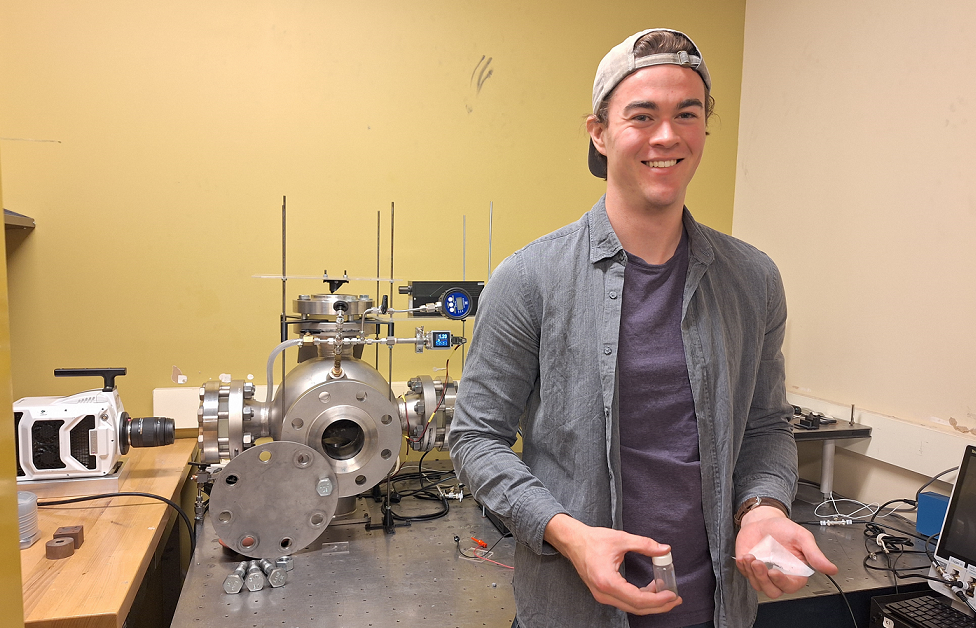Researchers in Waterloo, Ont. hope to pave the way for lunar development using moon's soil
For some, living on the moon is an idea that is truly out of this world. But for others, it’s a concept edging closer to reality.
“We are one of the dozens, maybe around the world that actually works out things to turn our space dream into something actually possible,” said Anqi Wang, a post-doctoral fellow with the Emerging Energy Research Laboratory at the University of Waterloo.
A team of researchers from the University of Waterloo, supervised by John Wen, Columbiad Space Research Chair for In-Situ Resource Utilization and Stewardship, and Jean-Pierre Hickey in Waterloo's Department of Mechanical and Mechatronics Engineering, are on a mission to figure out how they can use the moon's soil to create energy and help support life on the moon.
“Our goal is to provide the energy that will be required for doing these kind of long term goals for people to actually survive, to work, to live,” Wang explained.
It’s a project that is exciting for all who are involved.
“So I had my PhD in the United States at the University of Missouri and I worked solely on combustion. Nothing related to space. But coming here, I do more than just combustion. It’s turning something from entirely theory to more practical application. And with such a big possibility to be used in such an exciting project,” Wang said.
“Honestly, as a kid, you just think, ‘oh my, look at the moon up there, I wonder what we can do with it’ and then we end up having projects like this,” said co-op student, Jack Ehling.
For PhD candidate, Connor MacRobbie, it's an opportunity to turn science fiction into reality.
“So the end goal, at least of these projects would be to further our understanding of how to manufacture these materials, to provide sufficient energy or heat for specific use cases,” MacRobbie said.
 Connor MacRobbie holds a sample of synthesized regolith at a University of Waterloo lab on June 12, 2024. (Shelby Knox/CTV News)
Connor MacRobbie holds a sample of synthesized regolith at a University of Waterloo lab on June 12, 2024. (Shelby Knox/CTV News)
Building lunar infrastructure requires substantial materials, but according to MacRobbie, transporting these from earth is costly and impractical. This challenge is driving the team to investigate how lunar regolith, the moon’s top layer of soil and dust, can be used to generate energy.
“So we're trying to limit the amount of resources taken from the earth to space. One thing that we're starting to look at is how to use space debris as a fuel source.”
The team conducted experiments using simulant lunar regolith synthesized and supplied by the National Aeronautics and Space Administration agency (NASA).
“So in our case, we're using lunar regolith, and our lab expertise is in combustion. So we're focusing on using the lunar regolith as an oxidizer and a metal thermite reaction. So we're using it to generate heat and energy,” MacRobbie explained.
The approach is also addressing a problem with space debris as the team is working on repurposing this space junk into fuel.
“Looking at making a sustainable infrastructure that allows us to recycle old satellites, refine lunar regolith, pull the materials that we want from that regolith, use it as a building material,” MacRobbie said.
The team said there’s a long journey ahead in creating a self-sufficient lunar environment, but there is hope.
“Is it actually going to amount to anything? At this point I really do think it will. We're doing a lot of great work and there's a lot of good prospects for us moving forward,” MacRobbie said.
CTVNews.ca Top Stories
Raised in Sask. after his family fled Hungary, this man spent decades spying on communists for the RCMP
As a Communist Party member in Calgary in the early 1940s, Frank Hadesbeck performed clerical work at the party office, printed leaflets and sold books.
Bird flu, measles top 2025 concerns for Canada's chief public health officer
As we enter 2025, Dr. Theresa Tam has her eye on H5N1 bird flu, an emerging virus that had its first human case in Canada this year.
DEVELOPING Body found in wheel well of plane at Maui airport
A person was found dead in the wheel well of a United Airlines flight to Maui on Tuesday.
Police identify victim of Christmas Day homicide in Hintonburg, charge suspect
The Ottawa Police Service says the victim who has been killed on Christmas Day in Hintonburg has been identified.
Christmas shooting at Phoenix airport leaves 3 people wounded
Police are investigating a Christmas shooting at Sky Harbor Airport in Phoenix that left three people injured by gunfire.
Ship remains stalled on St-Lawrence River north of Montreal
A ship that lost power on the St. Lawrence River on Christmas Eve, remains stationary north of Montreal.
Finland stops Russia-linked vessel over damaged undersea power cable in Baltic Sea
Finnish authorities detained a ship linked to neighboring Russia as they investigate whether it damaged a Baltic Sea power cable and several data cables, police said, in the latest incident involving disruption of key infrastructure.
Your kid is spending too much time on their phone. Here's what to do about it
Wondering what your teen is up to when you're not around? They are likely on YouTube, TikTok, Instagram or Snapchat, according to a new report.
Bird flu kills more than half the big cats at a Washington sanctuary
Bird flu has been on the rise in Washington state and one sanctuary was hit hard: 20 big cats – more than half of the facility’s population – died over the course of weeks.






























